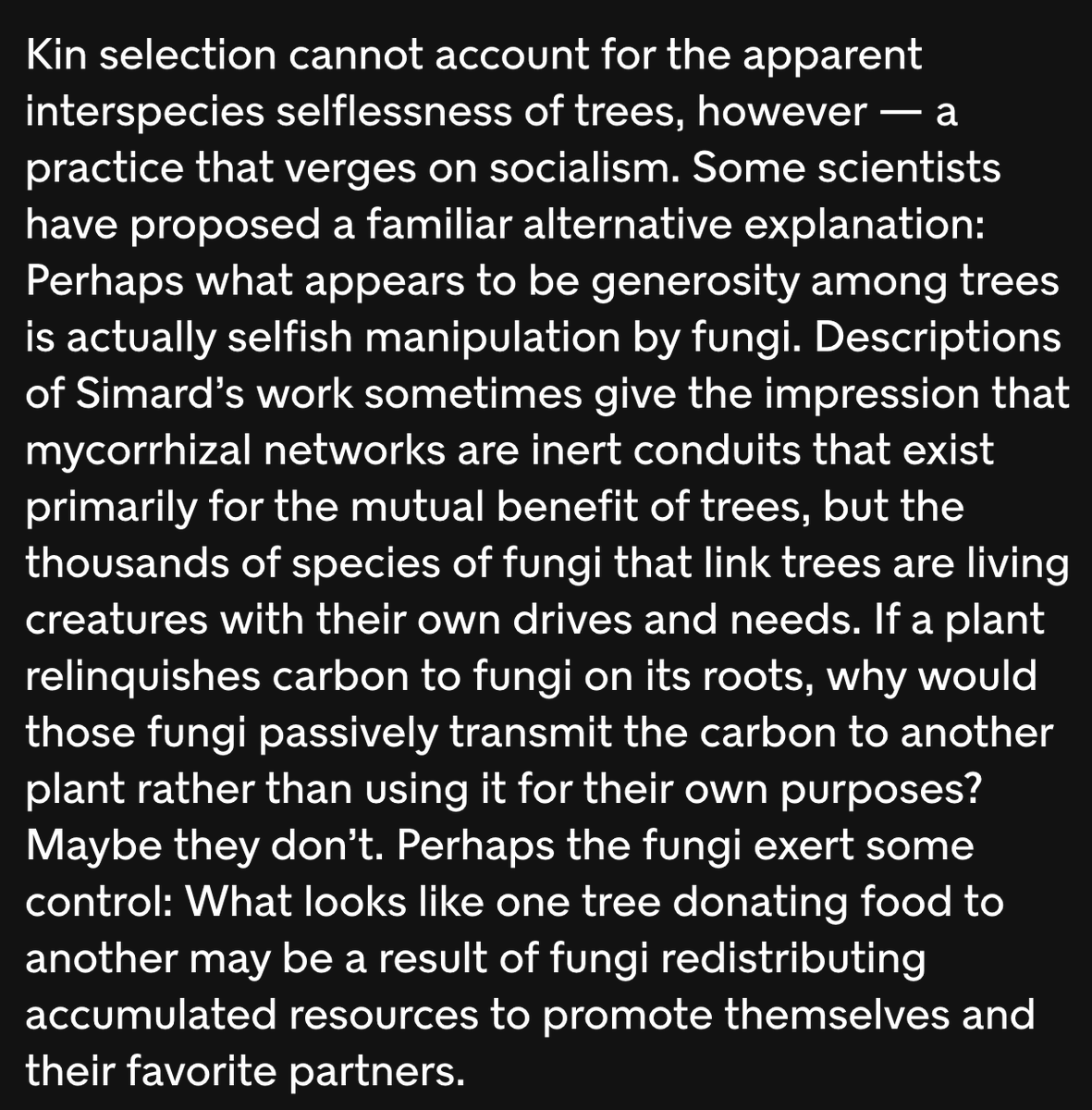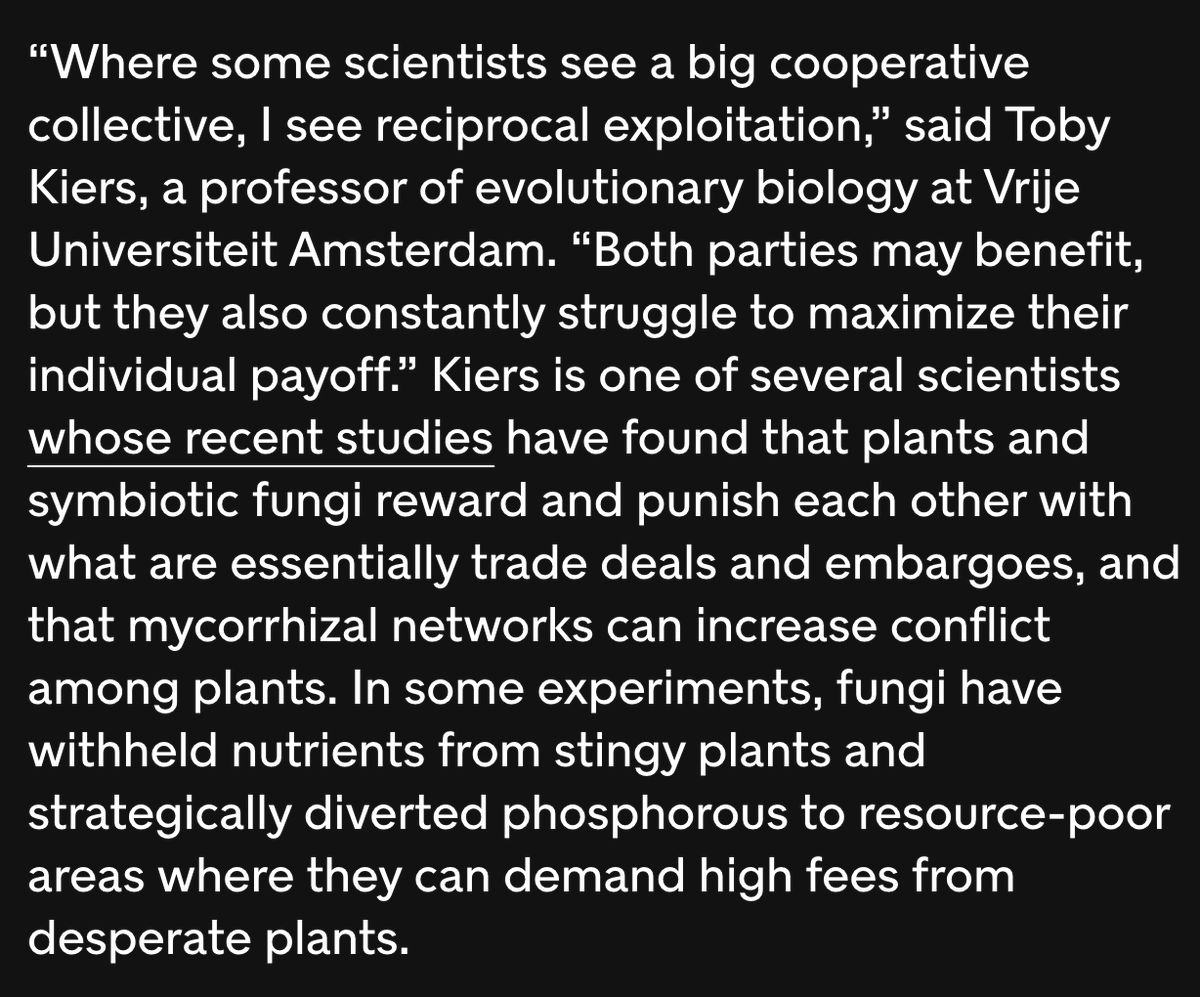For @NYTmag I wrote about hidden networks of root and fungi, how trees continually exchange resources and information, and a visionary scientist who changed our understanding of forests and inspired one of the central characters in 'The Overstory' https://www.nytimes.com/interactive/2020/12/02/magazine/tree-communication-mycorrhiza.html
Research in the past few decades has revealed that plants are far more social & perceptive than once thought. Plants can distinguish strangers vs kin, detect neighbors' chemical warnings, summon insect bodyguards, & adapt their behavior; one vine even shapeshifts for camouflage
When Suzanne Simard began studying forests in the ~'90s, scientists knew that fungi-root symbioses (mycorrhizas) connected plants and were prob ecologically important, but no one had seriously studied them in the wild.
What she discovered was far beyond what anyone imagined.
What she discovered was far beyond what anyone imagined.
Underground, vast webs of symbiotic fungi link essentially every tree in a forest, even those of diff species. Trees exchange carbon, water, nutrients, and chemical messages through these networks, ultimately helping each other survive, especially in times of stress and sickness.
"Motionless things that grow is mass mixed communities must have evolved ways to synchronize with one another," observes Patricia Westerford in 'The Overstory'
The plants and fungi in a forest are so connected and communicative, some have described them as superorganisms.
The plants and fungi in a forest are so connected and communicative, some have described them as superorganisms.
Here's the question, though: why would trees of diff species donate resources to each other at their own expense? And why would fungi obligingly transport those resources rather than using them?
Maybe what looks like straightforward cooperation is much more complex negotiation:
Maybe what looks like straightforward cooperation is much more complex negotiation:
Ultimately, the existence of interspecies networks themselves might be more important the particulars of their inner workings. The end result is the same: What one tree produces can feed, inform or rejuvenate another, and these beneficial relationships persist through generations
The emerging understanding of trees as social creatures demands changes to forestry.
Forests are vital to Earth's wellbeing. Trees helped create the first soils and oxygenate the atmosphere; they store immense amounts of carbon and regulate climate. They provide food and shelter
Forests are vital to Earth's wellbeing. Trees helped create the first soils and oxygenate the atmosphere; they store immense amounts of carbon and regulate climate. They provide food and shelter
Clearcutting not only kills majestic old-growth trees—it also devastates the symbiotic root-fungi networks in the forest floor, collapsing an ancient republic whose interspecies covenant of reciprocation and compromise is essential for the survival of Earth as we’ve known it.
While reporting this story I realized I hardly knew what a tree was. I had regarded them individually, each a magnificent living pillar between earth and sky.
But a tree is not self-contained. A tree is a composite creature of bewildering proportions and secret sinews.
But a tree is not self-contained. A tree is a composite creature of bewildering proportions and secret sinews.
Plants and fungi were once small, unacquainted ocean expats, still slick with seawater, searching for new opportunities. In collaboration with microbes, they became a collective life form of unprecedented might and magnanimity, sweeping the continents and transforming Earth.
I'm gobsmacked by the beautiful, immersive online presentation, and so happy that trees will be on the cover of the print magazine Sun Dec 6th
Much gratitude to @NYTmag team @willystaley @cwhe @KyleLigman Brendan George Ko Cynthia Cotts Steven Stern @jakesilverstein et al
Much gratitude to @NYTmag team @willystaley @cwhe @KyleLigman Brendan George Ko Cynthia Cotts Steven Stern @jakesilverstein et al

 Read on Twitter
Read on Twitter



